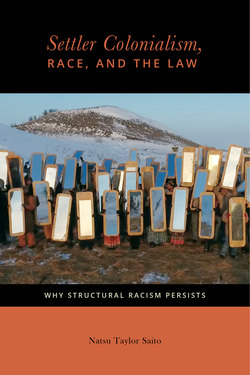Читать книгу Settler Colonialism, Race, and the Law - Natsu Taylor Saito - Страница 31
На сайте Литреса книга снята с продажи.
4 Land and Indigenous Peoples
ОглавлениеIn order to be a successful settler colony, one must commit genocide against the traditional owners of the land.
—Stokely Carmichael (Kwame Ture)
In the Angloamerican master narrative, the United States represents the culmination of Western civilization, and Western civilization, in turn, embodies the highest stage of human development. The narrative is embedded in a worldview that presumes its own universality, sees human history as linear and progressive, defines progress in terms of human dominion over the natural world, and constructs hierarchies of peoples based upon their level of “development.” As the origin story of the settler state, it begins with European colonizers and unfolds as a tale of their triumph over all enemies, including the “wilderness.” A primary theme is territorial control, for land “is not merely a component of settler society but its basic precondition.”1
Securing its land base has been and remains integral to the United States’ establishment and expansion, the creation of its wealth and power, and the maintenance of its global hegemony. This is why the cry of “border control” has such resonance among those who see their interests aligning with those of the state. The central narrative is also, of course, a story about people, but only as seen through settler eyes. The primary actors are European colonizers and their descendants—particularly male settlers, in accordance with their patriarchal worldview.
Indigenous peoples are problematic to this narrative. Their very existence calls into question the legitimacy of settler occupation and, thus, their nations have been targeted for destruction, containment, and conceptual disappearance. As Cherokee artist Jimmie Durham put it, “The settlers must consume us. There is no one to challenge their ownership except ourselves, which of course cannot be allowed.”2 The appropriation of land and natural resources thus “requires the elimination of the owners of that territory, but not in any particular way.”3 This is a foundational premise of American history, a reality that—as Derrick Bell noted about the intractability of racial subordination—“many will wish to deny, but none can refute.”4 At this point it is tempting, at least to many non-Indigenous people, to say, “Yes, yes, we know it was ugly, but it’s all in the past and we just need to move on.” Exasperated by being told “Don’t go there” when she talks about race, Korean American comedian Margaret Cho responds, “I live there. I bought a house there.”5 We, too, live there—here—and we cannot deconstruct the racism that permeates American society without being willing to confront its origins and the functions it continues to serve.
How the United States acquired and maintains its territorial base is rarely subjected to close scrutiny. Among non-Indigenous people, some attribute this to the belief that there is no point in feeling guilty about things we cannot change. However, if we really could not change anything it is unlikely that the resistance would be so adamant. It is the possibility of fundamental change that makes “going there” scary, tempting us to simply accept colonial occupation as a given, rather than to consider the implications of decolonization. A functional analysis that begins with space—the acquisition and maintenance of territorial control—is critical to understanding and countering the strategies that have been and continue to be used to keep all those deemed Other literally and figuratively “in our place.” The exploitation of non-Indigenous peoples of color forced or induced to migrate to the United States required land, the “basic precondition” of settler society, and the institutionalized racism we live with today originated in the strategies utilized to occupy Indigenous lands.
This chapter lays the foundation for an analysis of the racial subordination of non-Indigenous Others by summarizing some of the strategies employed by American settlers to occupy the land, appropriate its resources, and exercise their claimed sovereign prerogative. Lorenzo Veracini identifies twenty-six practices or “transfer strategies” commonly used by settler colonists to remove Indigenous peoples from their lands and from settler consciousness.6 Using his taxonomy as a starting point, this chapter looks at settler attempts to “disappear” American Indian nations, beginning with the “racing” of Indigenous peoples in the colonial narrative and then addressing strategies of elimination, displacement and containment, and conceptual disappearance.
